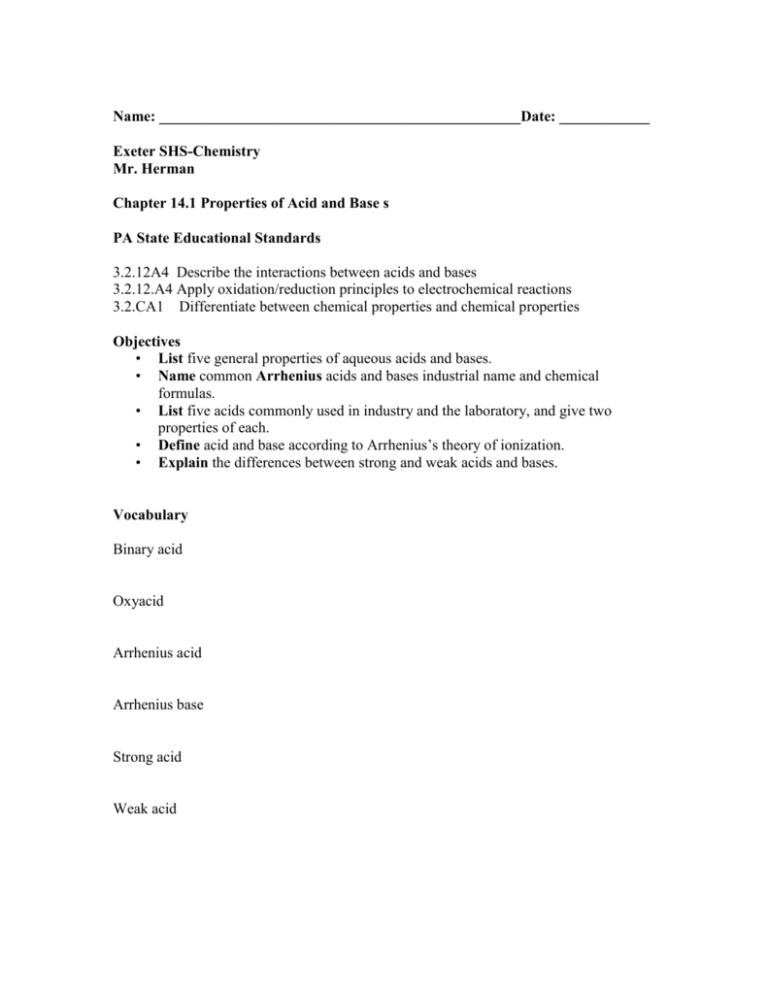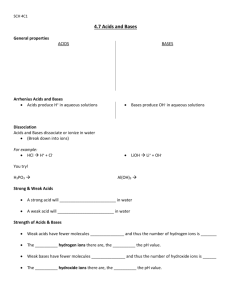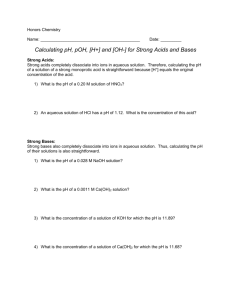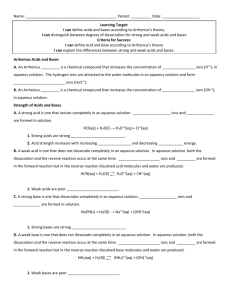Section 14.1 Properties of Acids and Bases
advertisement

Name: ________________________________________________Date: ____________ Exeter SHS-Chemistry Mr. Herman Chapter 14.1 Properties of Acid and Base s PA State Educational Standards 3.2.12A4 Describe the interactions between acids and bases 3.2.12.A4 Apply oxidation/reduction principles to electrochemical reactions 3.2.CA1 Differentiate between chemical properties and chemical properties Objectives • List five general properties of aqueous acids and bases. • Name common Arrhenius acids and bases industrial name and chemical formulas. • List five acids commonly used in industry and the laboratory, and give two properties of each. • Define acid and base according to Arrhenius’s theory of ionization. • Explain the differences between strong and weak acids and bases. Vocabulary Binary acid Oxyacid Arrhenius acid Arrhenius base Strong acid Weak acid Properties of Acids Acids 1. Aqueous solutions of acids have a sour taste. 2. Acids change the color of acid-base indicators. 3. Some acids react with active metals and release hydrogen gas, H2. Ba(s) + H2SO4(aq) → BaSO4(s) + H2(g) . Acids react with bases to produce salts and water. 5. Acids conduct electric current. Acid Nomenclature • A binary acid is an acid that contains only two different elements: hydrogen and one of the more electronegative elements. • HF, HCl, HBr, and HI • Binary Acid Nomenclature 1. The name of a binary acid begins with the prefix hydro-. 2. The root of the name of the second element follows this prefix. 3. The name then ends with the suffix -ic. • • • Acid Nomenclature An oxyacid is an acid that is a compound of hydrogen, oxygen, and a third element, usually a nonmetal. • HNO3, H2SO4 • The names of oxyacids follow a pattern. The names of their anions are based on the names of the acids. Some Common Industrial Acids • Sulfuric Acid • Sulfuric acid is the most commonly produced industrial chemical in the world. • Nitric Acid • Phosphoric Acid • Hydrochloric Acid • Concentrated solutions of hydrochloric acid are commonly referred to as muriatic acid. • Acetic Acid • Pure acetic acid is a clear, colorless, and pungent-smelling liquid known as glacial acetic acid. Properties of Bases • 1. Aqueous solutions of bases taste bitter. • 2. Bases change the color of acid-base indicators. • 3. Dilute aqueous solutions of bases feel slippery. • 4. Bases react with acids to produce salts and water. • 5. Bases conduct electric current. Arrhenius Acids and Bases • An Arrhenius acid is a chemical compound that increases the concentration of hydrogen ions, H+, in aqueous solution. • An Arrhenius base is a substance that increases the concentration of hydroxide ions, OH−, in aqueous solution. Aqueous Solutions of Acids • Arrhenius acids are molecular compounds with ionizable hydrogen atoms. • Their water solutions are known as aqueous acids. • All aqueous acids are electrolytes. Common Aqueous Acids Strength of Acids • A strong acid is one that ionizes completely in aqueous solution. • a strong acid is a strong electrolyte • HClO4, HCl, HNO3 • A weak acid releases few hydrogen ions in aqueous solution. • hydronium ions, anions, and dissolved aci molecules in aqueous solution • HCN • Organic acids (—COOH), such as acetic acid Aqueous Solutions of Bases • Most bases are ionic compounds containing metal cations and the hydroxide anion, OH−. • dissociate in water NaOH(s) → Na+ (aq) + OH- (aq) • Ammonia, NH3, is molecular • Ammonia produces hydroxide ions when it reacts with water molecules. NH3(aq) + H2O (l) → NH4+ (aq) + OH-(aq) Strength of Bases • The strength of a base depends on the extent to which the base dissociates. • Strong bases are strong electrolytes









